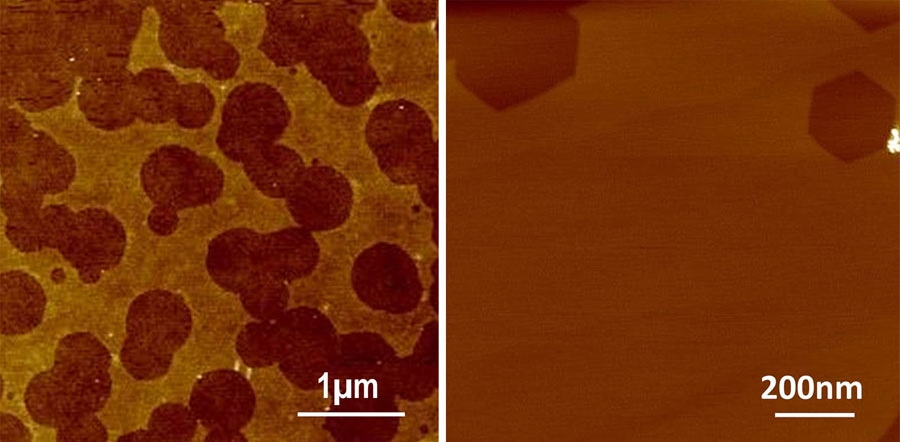Aug 2 2016
 Graphene etched with an underlying silica substrate produces uneven edges (figure 1) but forms precise edges when placed on boron nitride (figure 2). CREDIT: Guangyu Zhang
Graphene etched with an underlying silica substrate produces uneven edges (figure 1) but forms precise edges when placed on boron nitride (figure 2). CREDIT: Guangyu Zhang
It has become feasible to create a high-quality material - monolayer graphene nanoribbon with zigzag edges - for semiconductors and spintronic devices.
Due to their predicted electronic properties, tiny ribbons of graphene have become the preferred building blocks for semiconductor devices. However, the production of these nanostructures has continued to be a challenge for researchers.
A team of scientists from Japan and China have developed a new process to make the nanostructures in the laboratory. Their findings are published in the current issue of Applied Physics Letters, from AIP Publishing.
Many studies have predicted the properties of graphene nanoribbons with zigzag edges, but in experiments it’s very hard to actually make this material.
Guangyu Zhang, Beijing Key Laboratory
In the past, scientists have tried to produce graphene nanoribbons by placing the graphene sheets on a silica layer and using atomic hydrogen to cut strips with zigzag edges through the anisotropic etching process. These zigzag edges are vital to modulate the properties of nanoribbons.
However, the anisotropic etching technique only worked well to produce ribbons with two or more graphene layers. Since irregularities in silica with electronic peaks and valleys harden its surface, creating accurate zigzag edges on graphene monolayers were a challenge for researchers. Zhang and his partners from the Beijing Key Laboratory for Nanomaterials and Nanodevices, Chinese Academy of Sciences, and the Collaborative Innovation Center of Quantum Matter join force with Japanese colleagues from the National Institute for Materials Science to resolve the problem.
The researchers substituted the underlying silica substrate with boron nitride, a crystalline material that is chemically slow and has as smooth surface with no electronic bumps and pits. Using this substrate and the anisotropic etching process, they successfully produced graphene nanoribbons that had precise zigzag edges with only one-layer thickness
“This is the first time we have ever seen that graphene on a boron nitride surface can be fabricated in such a controllable way,” Zhang explained.
The nanoribbons with zigzag edges demonstrated high electron mobility around 2000 cm2/Vs at typical widths of less than 10 nm. This is the highest value ever reported for these nanostructures. These zigzag-edged nanoribbons also formed clean and narrow energy band gaps, making them potential materials for nano-electronic and spintronic devices.
When you decrease the width of the nanoribbons, the mobility decreases drastically because of edge defects. Using standard lithography fabrication techniques, studies have seen mobility of 100 cm2/Vs or even lower, but our material still exceeds 2000 cm2/Vs even at the sub-10 nanometer scale, demonstrating that these nanoribbons are of very high quality.
Guangyu Zhang, Beijing Key Laboratory
In the future, expanding this technique to produce different types of substrates could enable rapid processing of graphene monolayers on a large scale to make high-quality zigzag-edged nanoribbons.